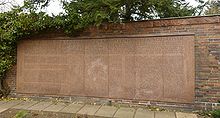Paul Eisenschneider
Paul Eisenschneider (born May 5, 1901 in Fischbach ; † April 19, 1944 in Mauthausen concentration camp ) was a German communist and resistance fighter against National Socialism .
Life
Paul Eisenschneider grew up in a family of teachers. After attending elementary school and the Göttenbach grammar school in Idar-Oberstein, he signed up in 1917 as a one-year volunteer for the Imperial Navy . He was one of the participants in the Kiel sailors uprising in 1918. In March 1920 he took part in the resistance against the Kapp Putsch . He later trained as a gemstone cutter. He became a member of the USPD and joined the KPD in 1922 , for which he entered the local council. In 1923 he married Ella Korb , the daughter of his teacher. In 1927 he took over the management of the KPD organization in his hometown. After a course at the Reichsparteischule of the KPD "Rosa-Luxemburg" in Fichtenau he became in 1931 a member of the KPD district leadership Rhein-Saar and head of the KPD sub-district Birkenfeld. In 1932 he was elected member of the state parliament.
Because he dealt with National Socialism early on, he had to leave the Oldenburg region of Birkenfeld at the end of 1932 after the election victory and the takeover of the NSDAP and move to the nearby Saar area , which was still autonomous at the time. From there he took an active part in the resistance against the Nazi dictatorship. From the Saar area he organized the transport of the KPD newspapers Rote Fahne and Junge Garde as well as brochures and other anti-fascist information material to the “Reichsgebiet”. In order to get hold of him, his wife was so badly mistreated by SA and " Stahlhelm " people during a house search on March 7, 1933 that she became a cripple. The family then emigrated to the Soviet Union to prevent further danger. Paul Eisenschneider attended the International Lenin School in Moscow from 1934 to 1936 .
After this course, Paul Eisenschneider worked on behalf of the Central Committee of the KPD for the West Section in Amsterdam . He helped organize the resistance in the Ruhr area. From Essen he tried to implement the resolutions of the Brussels Conference of the KPD of 1935, in which he had probably participated, to form a united front with social democratic and Christian Nazi opponents. Its task was to organize political resistance and to maintain contacts between the SPD, KPD and SAP .
On September 15, 1936, he was arrested in Bochum and sentenced on May 24, 1937 to life imprisonment by the 2nd Senate of the People's Court "for preparing high treason under aggravating circumstances".
Eisenschneider stayed in the Münster prison until 1943 , when he was transferred to the Mauthausen concentration camp. According to the camp administration, Paul Eisenschneider died on April 19, 1944 of cardiovascular problems. According to literature based on statements from fellow inmates, Paul Eisenschneider is said to have been murdered by SS men in the cement tunnel of the concentration camp.
His daughter Elvira Eisenschneider was murdered in Sachsenhausen concentration camp in 1944 .
Commemoration
The names of Paul Eisenschneider and his daughter Elvira Eisenschneider are engraved on the large plaque of the memorial of the socialists in Berlin's Friedrichsfelde central cemetery in the Lichtenberg district .
In Dranske on the island of Rügen a street is named after Paul Eisenschneider.
Two ships of the Volksmarine were named after Paul Eisenschneider :
- a missile speedboat from Project 205 ( Osa class ), construction number 205/06, registration number 713; it was put into service on October 16, 1964 and after being decommissioned it was scrapped on November 4, 1981;
- a missile speedboat service number VM 574 of the People's Navy ( Tarantul class ); it was put into service on February 12, 1986 and after being decommissioned it was scrapped on October 3, 1990.
literature
- Dieter May: Paul and Elvira Eisenschneider - Two forgotten resistance fighters against National Socialism . In: Home calendar 1987 in the Birkenfeld district
- Luitwin Bies: Paul, Ella and Elvira. About the life of the Eisenschneiders from Fischbach an der Nahe. Ed .: Alternative list of the district of Birkenfeld. Idar-Oberstein 2001
- Luise Kraushaar : German resistance fighters 1933 to 1945. Volume 1. Dietz, Berlin 1970, p. 223ff
- Eisenschneider, Paul . In: Hermann Weber , Andreas Herbst : German Communists. Biographical Handbook 1918 to 1945 . 2nd, revised and greatly expanded edition. Dietz, Berlin 2008, ISBN 978-3-320-02130-6 .
Individual evidence
- ^ Entry on Paul Eisenschneider in the Rhineland-Palatinate personal database , accessed on March 20, 2017 .
- ↑ drafd.de
| personal data | |
|---|---|
| SURNAME | Eisenschneider, Paul |
| BRIEF DESCRIPTION | German communist functionary and resistance fighter |
| DATE OF BIRTH | May 5, 1901 |
| PLACE OF BIRTH | Fischbach |
| DATE OF DEATH | April 19, 1944 |
| Place of death | Mauthausen concentration camp |
